Pit Lakes in Abandoned Slate Quarries in Northwestern Spain: Characteristics and Potential Uses
Abstract
1. Introduction
2. Materials and Methods
3. Results
4. Discussion
5. Conclusions
Supplementary Materials
Author Contributions
Funding
Data Availability Statement
Conflicts of Interest
References
- Mossa, J.; James, L.A. 13.6 Impacts of Mining on Geomorphic Systems. Treatise Geomorphol. 2013, 13, 74–95. [Google Scholar] [CrossRef]
- Townsend, P.A.; Helmers, D.P.; Kingdon, C.C.; McNeil, B.E.; Beurs, K.M.; Eshleman, K.N. Changes in the extent of surface mining and reclamation in the Central Appalachians detected using a 1976–2006 Landsat time series. Remote Sens. Environ. 2009, 113, 62–72. [Google Scholar] [CrossRef]
- Tarolli, P.; Sofia, G. Human topographic signatures and derived geomorphic processes across landscapes. Geomorphology 2016, 255, 140–161. [Google Scholar] [CrossRef]
- Reece, E. Lost Mountain. A Year in the Vanishing Wilderness Radical Strip Mining and the Devastation of Appalachia; Riverhead Books: New York, NY, USA, 2006. [Google Scholar]
- Bernhardt, E.S.; Palmer, M.A. The environmental costs of mountaintop mining valley fill operations for aquatic ecosystems of the Central Appalachians. Ann. N. Y. Acad. Sci. 2011, 1223, 39–57. [Google Scholar] [CrossRef] [PubMed]
- Palmer, M.A.; Bernhardt, E.S.; Schlesinger, W.H.; Eshleman, K.N.; Foufoula-Georgiou, E.; Hendryx, M.S.; Lemly, A.D.; Likens, G.E.; Loucks, O.L.; Power, M.E.; et al. Mountaintop mining consequences. Science 2010, 327, 148–149. [Google Scholar] [CrossRef]
- Wickham, J.; Bohall Wood, P.; Nicholson, M.C.; Jenkins, W.; Druckenbrod, D.; Suter, G.W.; Strager, M.P.; Mazzarella, C.; Galloway, W.; Amos, J. The overlooked terrestrial impacts of mountaintop mining. BioScience 2013, 63, 335–348. [Google Scholar] [CrossRef]
- Edwards, J.A.; Llurdés I Coit, J.C. Mines and quarries: Industrial heritage tourism. Ann. Tour. Res. 1996, 23, 341–363. [Google Scholar] [CrossRef]
- García-Sánchez, L.; Canet, C.; Cruz-Pérez, M.Á.; Morelos-Rodríguez, L.; Salgado-Martínez, E.; Corona-Chávez, P. A comparison between local sustainable development strategies based on the geoheritage of two post-mining areas of Central Mexico. Int. J. Geoherit. Parks 2021, 9, 391–404. [Google Scholar] [CrossRef]
- Gioncada, A.; Pitzalis, E.; Cioni, R.; Fulignati, P.; Lezzerini, M.; Mundula, F.; Funedda, A. The volcanic and mining geoheritage of San Pietro Island (Sulcis, Sardinia, Italy): The potential for geosite valorization. Geoheritage 2019, 11, 1567–1581. [Google Scholar] [CrossRef]
- Prosser, C.D. Geoconservation, Quarrying and Mining: Opportunities and Challenges Illustrated through Working in Partnership with the Mineral Extraction Industry in England. Geoheritage 2018, 10, 259–270. [Google Scholar] [CrossRef]
- Ruban, D.A.; Sallam, E.S.; Khater, T.M.; Ermolaev, V.A. Golden Triangle Geosites: Preliminary Geoheritage Assessment in a Geologically Rich Area of Eastern Egypt. Geoheritage 2021, 13, 54. [Google Scholar] [CrossRef]
- Vlachopoulos, N.; Voudouris, P. Preservation of the geoheritage and mining heritage of Serifos Island, Greece: Geotourism perspectives in a potential new global UNESCO geopark. Geosciences 2022, 12, 127. [Google Scholar] [CrossRef]
- Damas Mollá, L.; Aranburu, A.; García-Garmilla, F.; Uriarte, J.A.; Zabaleta, A.; Bodego, A.; Sagarna, M.; Antigüedad, I. Cantera Gorria and Red Ereño: Natural and Cultural Geoheritage (Basque Country, Spain). Geoheritage 2022, 14, 76. [Google Scholar] [CrossRef]
- López-García, J.A.; Oyarzun, R.; López Andrés, S.; Manteca Martínez, J. Scientific, educational, and environmental considerations regarding mine sites and geoheritage: A perspective from SE Spain. Geoheritage 2011, 3, 267–275. [Google Scholar] [CrossRef]
- Mazadiego, L.F.; Llamas, B.; de Górgolas, C.R.; Pous, J.; Puche, O. The Contingent Valuation Method Applied to the Mining Heritage of Extremadura (Spain). Geoheritage 2019, 11, 665–679. [Google Scholar] [CrossRef]
- Redondo Vega, J.M. Las Minas de Carbón a Cielo Abierto en la Provincia de León. Transformación del Medio y Explotación de Recursos no Renovables; Universidad de León, Secretariado de Publicaciones: León, Spain, 1988. [Google Scholar]
- Lund, M.A.; Blanchette, M.L. Closing pit lakes as aquatic ecosystems: Risk, reality, and future uses. Wires Water 2023, 10, e1648. [Google Scholar] [CrossRef]
- Hildmann, E.; Wünsche, M. Lignite mining and its after-effects on the Central German landscape. Water Air Soil Pollut. 1996, 91, 79–87. [Google Scholar] [CrossRef]
- Castro, J.M.; Moore, J.N. Pit lakes: Their characteristics and the potential for their remediation. Environ. Geol. 2000, 39, 1254–1260. [Google Scholar] [CrossRef]
- Gammons, C.H.; Harris, L.N.; Castro, J.M.; Cott, P.; Hanna, B.W. Creating lakes from open pit mines: Processes and considerations, with emphasis on northern environments. Can. Tech. Rep. Fish. Aquat. Sci. 2009, 2826, 1–117. [Google Scholar]
- Hangen-Brodersen, C.; Strempel, P.; Grünewald, U. Characteristics of catchments disturbed by lignite mining—Case study of Schlabendorf/Seese (Germany). Ecol. Eng. 2005, 24, 37–48. [Google Scholar] [CrossRef]
- Baeten, J.; Langston, N.; Lafreniere, D. A spatial evaluation of historic iron mining impacts on current impaired waters in Lake Superior’s Mesabi Range. Ambio 2018, 47, 231–244. [Google Scholar] [CrossRef]
- Nixdorf, B.; Lessmann, D.; Deneke, R. Mining lakes in a disturbed landscape: Application of the EC Water Framework Directive and future management strategies. Ecol. Eng. 2005, 24, 67–73. [Google Scholar] [CrossRef]
- Redondo-Vega, J.M.; González-Gutiérrez, R.B.; Melón-Nava, A.; Peña Pérez, S.A.; Santos-González, J.; Gómez-Villar, A. Cambios antiguos en el paisaje de origen minero en León (España): Localización y caracteres morfométricos de las lagunas auríferas romanas. In Proceedings of the VIII Congreso Internacional La Plata en Iberoamérica, León, Spain, 13–17 September 2021. [Google Scholar]
- Redondo-Vega, J.M.; Gómez-Villar, A.; Santos-González, J.; González-Gutiérrez, R.B.; Álvarez-Martínez, J. Changes in land use due to mining in the north-western mountains of Spain during the previous 50 years. Catena 2017, 149, 844–856. [Google Scholar] [CrossRef]
- Redondo-Vega, J.M.; Gómez-Villar, A.; González-Gutiérrez, R.B.; Santos-González, J. El origen de las lagunas de León. In Xeomorfoloxía e Paisaxes Xeográficas. Catro Décadas de Investigación e Ensino. Homenaxe a Augusto Pérez Alberti; Chao, R.B., Rodríguez, F.C., Casais, M.C., García, J.H., Díaz, M.V., Eds.; Universidade de Santiago de Compostela: Santiago de Compostela, Spain, 2018; pp. 469–486. [Google Scholar]
- Redondo-Vega, J.M.; Melón-Nava, A.; Peña-Pérez, S.A.; Santos-González, J.; Gómez-Villar, A.; González-Gutiérrez, R.B. Coal pit lakes in abandoned mining areas in León (NW Spain): Characteristics and geoecological significance. Environ. Earth Sci. 2021, 80, 792. [Google Scholar] [CrossRef]
- Zhao, L.Y.L.; McCullough, C.D.; Lund, M.A.; Management, M. Mine Voids Management Strategy (I): Pit Lake Resources of the Collie Basin. Mine Water and Environment Research/Centre for Ecosystem Management. 2009. Available online: https://www.water.wa.gov.au/data/assets/pdf_file/0012/5601/96275.pdf (accessed on 1 July 2024).
- Cárdenes, V.; Ponce de León, M.; Rodríguez, X.A.; Rubio-Ordóñez, A. Roofing Slate Industry in Spain: History, Geology, and Geoheritage. Geoheritage 2019, 11, 19–34. [Google Scholar] [CrossRef]
- Cárdenes, V.; Rubio, A.; Ruiz de Argandoña, V.G. Roofing slate from Bernardos, Spain: A potential candidate for global heritage stone. Episodes 2021, 44, 3–9. [Google Scholar] [CrossRef]
- Lindoso Tato, E. La industria de la pizarra española en perspectiva histórica. Investig. Hist. Económica 2019, 11, 52–61. [Google Scholar] [CrossRef]
- García de Celis, A.; González Fernández, A.M.; Redondo Vega, J.M. La explotación de pizarras ornamentales en Castilla y León. Ería 1993, 32, 251–264. [Google Scholar] [CrossRef]
- Ferrero Arias, A.; Baltuille Martín, J.M. (Eds.) Mapa de Minerales y Rocas Industriales de Galicia. Escala 1:250000; IGME-Xunta de Galicia: Galicia, Spain, 2008; Available online: https://info.igme.es/SidPDF/166000/585/166585_0000001.pdf (accessed on 1 July 2024).
- San Román Rodriguez, J.M. Valdeorras. La Industria de la Pizarra y las Transformaciones Espaciales. Municipios de O Barco, Carballeda y Rubiá (1950–1998); Cuaderno Monográfico; Instituto de Estudios Valdeorreses: Galicia, Spain, 2000; Volume 32. [Google Scholar]
- González Nicieza, C.; Taboada Castro, J.; Menéndez Díaz, A.; Álvarez Vigil, A.E. Geological risks in slag heaps of roofing slate in Spain. Int. J. Surf. Min. Reclam. Environ. 2007, 11, 145–150. [Google Scholar] [CrossRef]
- Pérez-Alberti, A. El patrimonio glaciar y periglaciar del Geoparque Mundial UNESCO Montañas do Courel (Galicia). Cuaternario Y Geomorfol. 2021, 35, 79–98. [Google Scholar] [CrossRef]
- Santos González, J.; Redondo Vega, J.M.; González Gutiérrez, R.; Gómez Villar, A. New data about The La Baña lake origin (Cabrera Range, NW Spain) using geomorphological and sedimentological analysis. Boletín Asoc. Geógrafos Españoles 2015. [Google Scholar] [CrossRef][Green Version]
- Gwyn, D. ‘The Slate Landscape of Northwest Wales’—A New Industrial World Heritage Site. Ind. Archaeol. Rev. 2023, 45, 19–31. [Google Scholar] [CrossRef]
- Price, W.R. Quarrying for World Heritage Designation: Slate Tourism in North Wales. Geoheritage 2019, 11, 1839–1854. [Google Scholar] [CrossRef]
- Goemaere, E.; Demarque, S.; Dreesen, R.; Declercq, P.Y. The Geological and Cultural Heritage of the Caledonian Stavelot-Venn Massif, Belgium. Geoheritage 2016, 8, 211–233. [Google Scholar] [CrossRef]
- McCullough, C.; Schultze, M.; Vandenberg, J. Realizing beneficial and uses from abandoned pit lakes. Minerals 2020, 10, 133. [Google Scholar] [CrossRef]
- Dwiyanto, M.R.; Damayanti, A.; Indra, T.L.; Dimyati, M. Land use changes due to mining activities in Penajam Paser Utara Regency, East Kalimantan Province. IOP Conf. Ser. Earth Environ. Sci. 2021, 1811, 012088. [Google Scholar] [CrossRef]
- Yu, L.; Xu, Y.; Xue, Y.; Li, X.; Cheng, Y.; Liu, X.; Porwal, A.; Holden, E.J.; Yang, J.; Gong, P. Monitoring surface mining belts using multiple remote sensing datasets: A global perspective. Ore Geol. Rev. 2018, 101, 675–687. [Google Scholar] [CrossRef]
- Werner, T.T.; Bebbington, A.; Gregory, G. Assessing impacts of mining: Recent contributions from GIS and remote sensing. Extr. Ind. Soc. 2019, 6, 993–1010. [Google Scholar] [CrossRef]
- Hakanson, L. A Manual of Lake Morphometry; Springer: Berlin/Heidelberg, Germany, 1981. [Google Scholar] [CrossRef]
- Del Castillo Jurado, M. Morfometría de Lagos. Aplicación a los Lagos del Pirineo. Ph.D. Thesis, Universitat de Barcelona, Barcelona, Spain, 2003. Available online: https://www.tesisenred.net/handle/10803/1428 (accessed on 1 July 2024).
- Vega, J.C.; De Hoyos, C.; Aldasoro, J.J.; De Miguel, J.; Fraile, H. Nuevos datos morfométricos para el Lago de Sanabria. Limnetica 2005, 24, 115–125. [Google Scholar] [CrossRef]
- Mijares Coto, M.J. Procedimiento de Actuación para la Aplicación de la Directiva Marco del Agua a los Lagos Artificiales Creados por la Rehabilitación de las Explotaciones Mineras a Cielo Abierto. Ph.D. Thesis, Universidade da Coruña, Corunha, Spain, 2013. Available online: http://hdl.handle.net/2183/11702 (accessed on 22 April 2023).
- Fuentes-Pérez, J.F.; Navarro Hevia, J.; Ruiz Legazpi, J.; García-Vega, A. Inventario y caracterización morfológica de lagos y lagunas de alta montaña en las provincias de Palencia y León (España). Pirineos 2015, 170, E013. [Google Scholar] [CrossRef]
- Contreras, F.I.; Paira, A.R. Comparación morfométrica entre lagunas de la planicie aluvial del río Paraná Medio y La Lomada Norte (Corrientes, Argentina). Cuad. Geogr. Rev. Colomb. Geogr. 2015, 24, 61–71. [Google Scholar] [CrossRef]
- Kalff, J. Limnology. Inland Water Ecosystems; Prentice Hall: Upper Saddle River, NJ, USA, 2002; Available online: https://livresbioapp.files.wordpress.com/2016/03/limnology-kalff.pdf (accessed on 1 July 2024).
- Al Heib, M.; Varouchakis, E.A.; Galetakis, M.; Renaud, V.; Burda, J. A framework for assessing hazards related to pit lakes: Application on European case studies. Environ. Earth Sci. 2023, 82, 365. [Google Scholar] [CrossRef]
- Kubalíková, L. Risk assessment on dynamic geomorphosites: A case study of selected abandoned pits in South-Moravian Region (Czech Republic). Geomorphology 2024, 458, 109249. [Google Scholar] [CrossRef]
- Renaud, V.; Al Heib, M.; Burda, J. 3D large-scale numerical model of open-pit lake slope stability-case study of Lake Most. Bull. Eng. Geol. Environ. 2022, 81, 282. [Google Scholar] [CrossRef]
- Wang, S.; Zhuang, Y.; Cao, Y.; Yang, K. Ecosystem Service Assessment and Sensitivity Analysis of a Typical Mine-Agriculture-Urban Compound Area in North Shanxi, China. Land 2022, 11, 1378. [Google Scholar] [CrossRef]
- Steiakakis, E.; Syllignakis, G.; Galetakis, M.; Vavadakis, D.; Renaud, V.; Al Heib, M.; Burda, J. Pit Lake Slope Stability under Water Level Variations. Geosciences 2024, 14, 142. [Google Scholar] [CrossRef]
- Yang, G.; Chen, Y.; Xie, Q.; Wu, P.; Zhang, Y. Physical and mechanical characteristics deterioration and crack evolution of sandy mudstone in an open-pit mine under multiple freeze-thaw cycles. Geomech. Geophys. Geo-Energy Geo-Resour. 2024, 10, 87. [Google Scholar] [CrossRef]
- Dziuba, E.; Buzmakov, S.; Khotyanovskaya, Y. Study of geochemical features of soils on the territory of an abandoned coal mining area using geoinformation technologies. Environ. Geochem. Health 2023, 45, 9135–9155. [Google Scholar] [CrossRef] [PubMed]
- Suhernomo, S.; Luthfi Fatah, L.; Saidy, A.R.; Priatmadi, B.J.; Noor, I.; Triwibowo, D. Strategies of water flow treatment of Paringin Pit Lake to meet wastewater discharge compliance. J. Degrad. Min. Lands Manag. 2023, 10, 4683–4695. [Google Scholar] [CrossRef]
- Soni, A.K.; Mishra, B.; Singh, S. Pit lakes as an end use of mining: A review. J. Min. Environ. 2014, 5, 99–111. [Google Scholar] [CrossRef]
- Eary, L.E. Geochemical and equilibrium trends in mine pit lakes. Appl. Geochem. 1999, 14, 963–987. [Google Scholar] [CrossRef]
- Gulpinar Sebkan, D.U.; Acar, C. Determining usages in post-mining sites according to landscape design approaches. Land Degrad. Dev. 2021, 32, 2661–2676. [Google Scholar] [CrossRef]
- Ayala Carcedo, F.J.; Vadillo Fernández, L. Manual de Restauración de Terrenos y Evaluación de Impactos Ambientales en Minería; Instituto Tecnológico Geominero de España: Madrid, Spain, 1989. [Google Scholar]
- Uhlmann, W.; Büttcher, H.; Totsche, O.; Steinberg, C.E.W. Buffering of Acidic Mine Lakes: The Relevance of Surface Exchange and Solid-Bound Sulphate. Mine Water Environ. 2004, 23, 20–27. [Google Scholar] [CrossRef]
- Gupta, S.; Palit, D.; Kar, D.; Mukherjee, A. Pitlakes of Raniganj Coal Field, W.B, India. Inventory and Water Quality Status; Natural Science, Technical Report; GRIN: München, Germany, 2019. [Google Scholar]
- Geller, W.; Schultze, M. Remediation and Management of Acidified Pit Lakes and Outflowing Waters. In Acidic Pit Lakes. Environmental Science and Engineering; Geller, W., Schultze, M., Kleinmann, R., Wolkersdorfer, C., Eds.; Springer: Berlin, Heidelberg, 2013. [Google Scholar] [CrossRef]
- Lee, N.R.; Lee, H.J.; Yoon, N.Y.; Kim, D.; Jung, M.; Choi, E.H. Acidic Water Bathing Could Be a Safe and Effective Therapeutic Modality for Severe and Refractory Atopic Dermatitis. Ann. Dermatol. 2016, 28, 126–129. [Google Scholar] [CrossRef]
- Matz, H.; Orion, E.; Wolf, R. Balneotherapy in dermatology. Dermatol. Ther. 2003, 16, 132–140. [Google Scholar] [CrossRef]
- Savage, K.S.; Ashley, R.P.; Bird, D.K. Geochemical Evolution of a High Arsenic, Alkaline Pit-Lake in the Mother Lode Gold District, California. Econ. Geol. 2009, 104, 1171–1211. [Google Scholar] [CrossRef]
- Kumar, R.N.; McCullough, C.D.; Lund, M.A. Water resources in Australian mine pit lakes. Min. Technol. Trans. Inst. Min. Metall. Sect. A 2009, 118, 205–211. [Google Scholar] [CrossRef]
- McCullough, C.; Lund, M.A. Opportunities for sustainable mining Pit Lakes in Australia. Mine Water Environ. 2006, 25, 220–226. [Google Scholar] [CrossRef]
- Geller, W.; Schultze, M.; Kleinmann, R.; Wolkersdorfer, C. (Eds.) Acidic Pit Lakes. In Environmental Science and Engineering; Springer: Berlin/Heidelberg, Germany, 2013. [Google Scholar] [CrossRef]
- Mantero, J.; Thomas, R.; Holm, E.; Rääf, C.; Vioque, I.; Ruiz-Canovas, C.; García-Tenorio, R.; Forssell-Aronsson, E.; Isaksson, M. Pit lakes from Southern Sweden: Natural radioactivity and elementary characterization. Sci. Rep. 2020, 10, 13712. [Google Scholar] [CrossRef]
- Varnell, C. Utilization of Abandoned Coal Mines as Sources of Municipal Water. Acad. Lett. 2021, 19, 251–258. [Google Scholar] [CrossRef]
- Varnell, C.J.; Van Brahana, J.; Steele, K. The Influence of Coal Quality Variation on Utilization of Water from Abandoned Coal Mines as a Municipal Water Source. Mine Water Environ. 2004, 23, 204–208. [Google Scholar] [CrossRef]
- Read, J.; Stacey, P. Guidelines for Open Pit Slope Design; CSIRO-CRC: Collingwood, VIC, Australia, 2009; 490p. [Google Scholar] [CrossRef]
- Abdulai, M.; Sharifzadeh, M. Probability Methods for Stability Design of Open Pit Rock Slopes: An Overview. Geosciences 2021, 11, 319. [Google Scholar] [CrossRef]
- Beale, G.; Read, J. Guidelines for Evaluating Water in Pit Slope Stability; CSIRO-CRC: Collingwood, VIC, Australia, 2013; 599p. [Google Scholar]
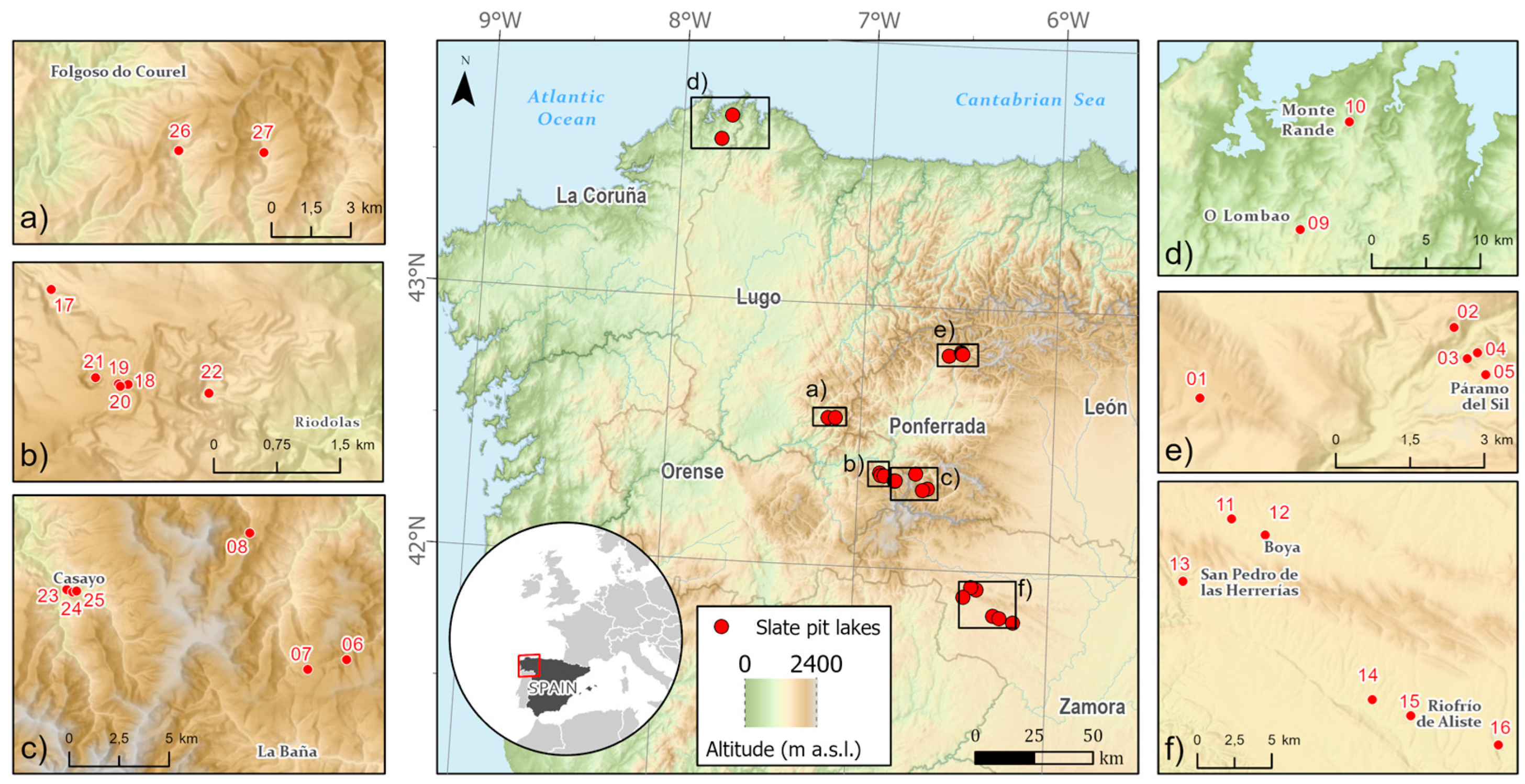
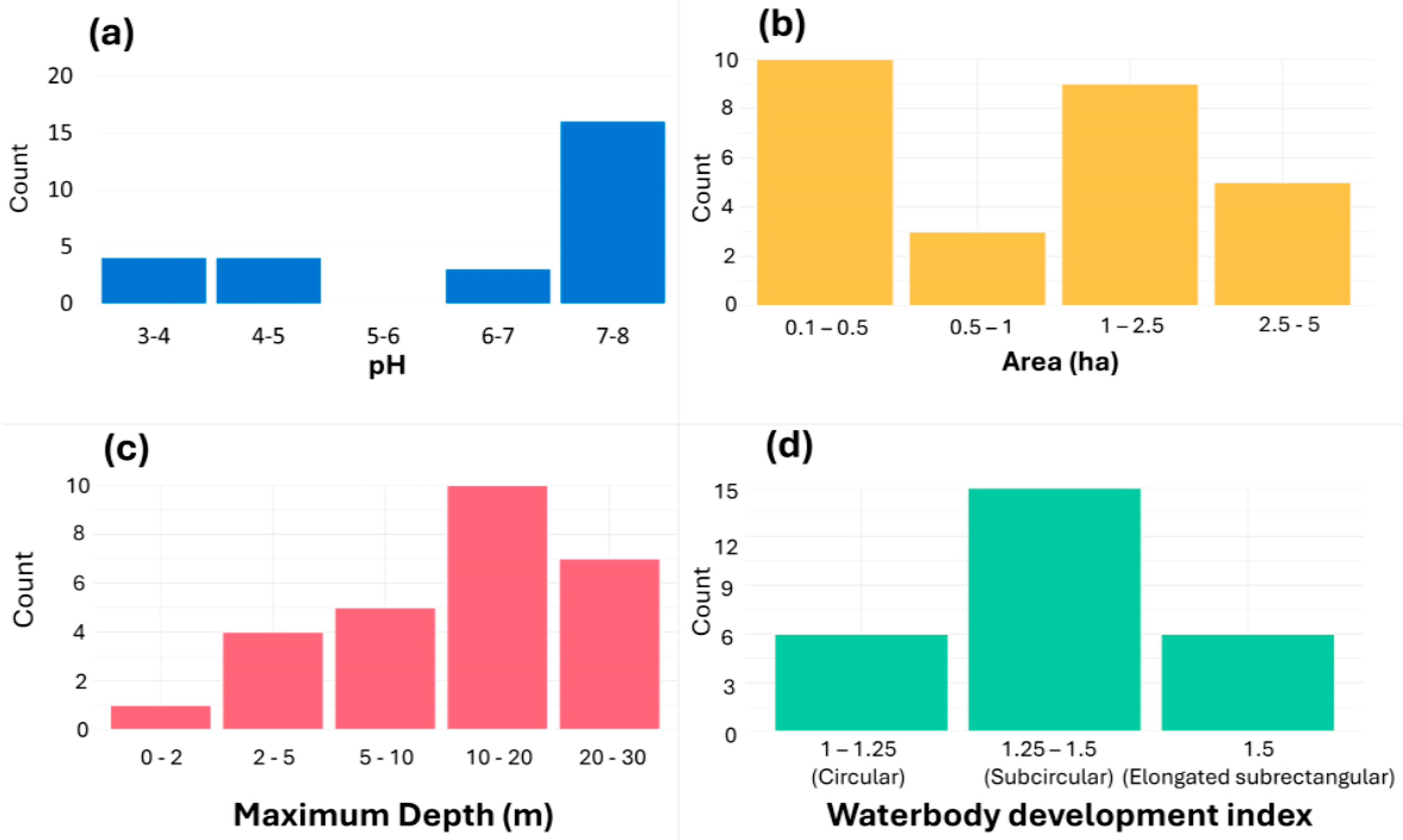
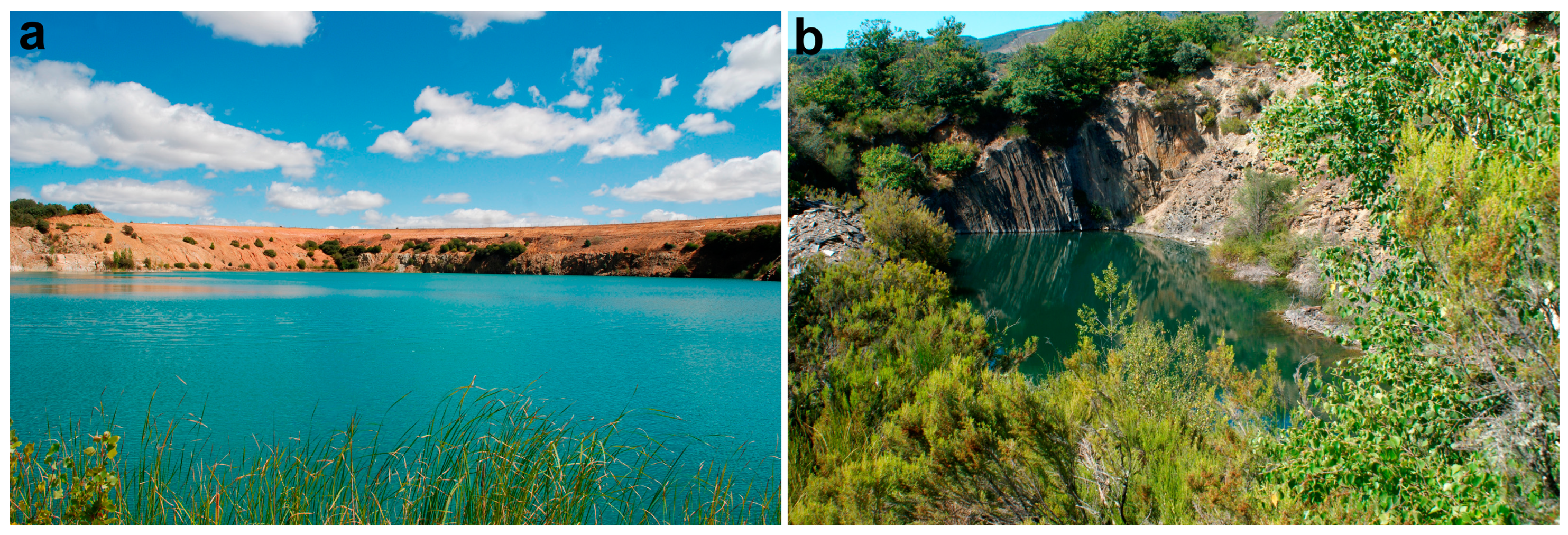
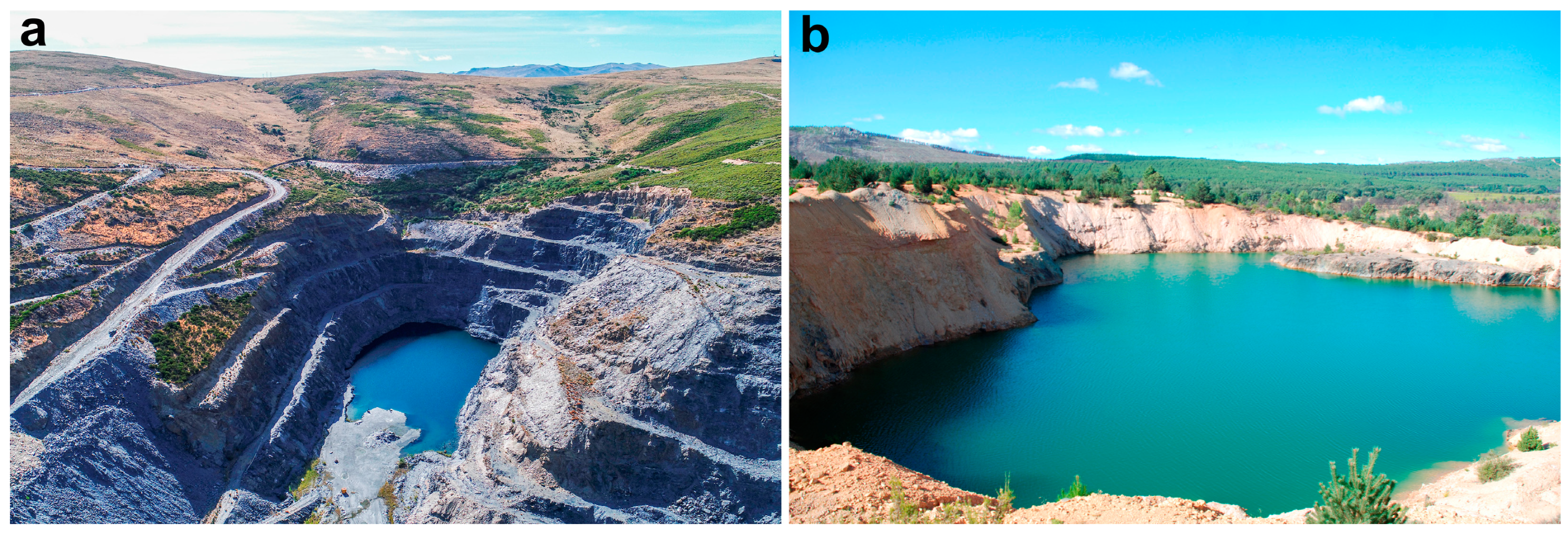
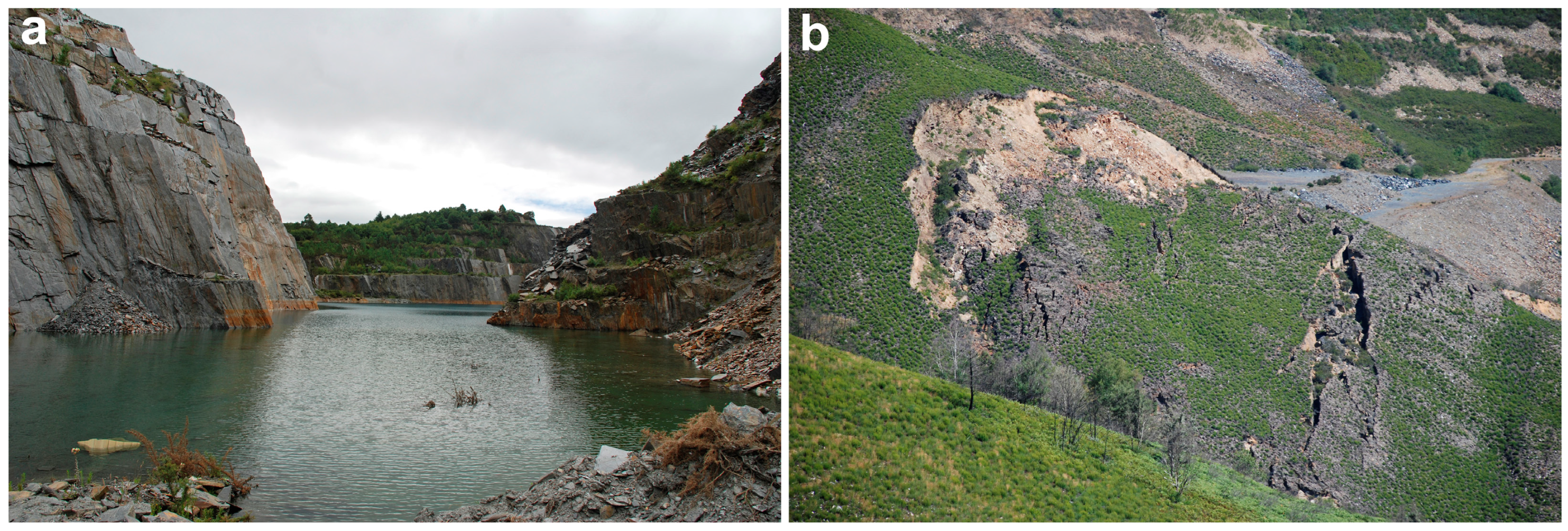
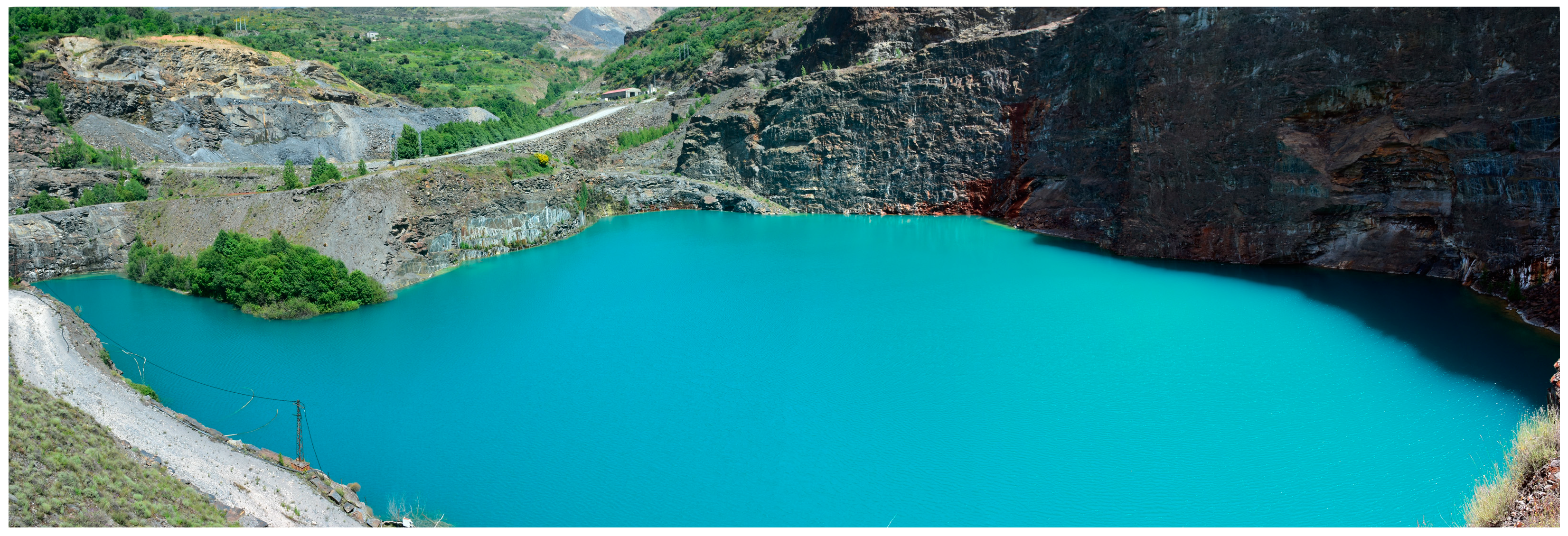
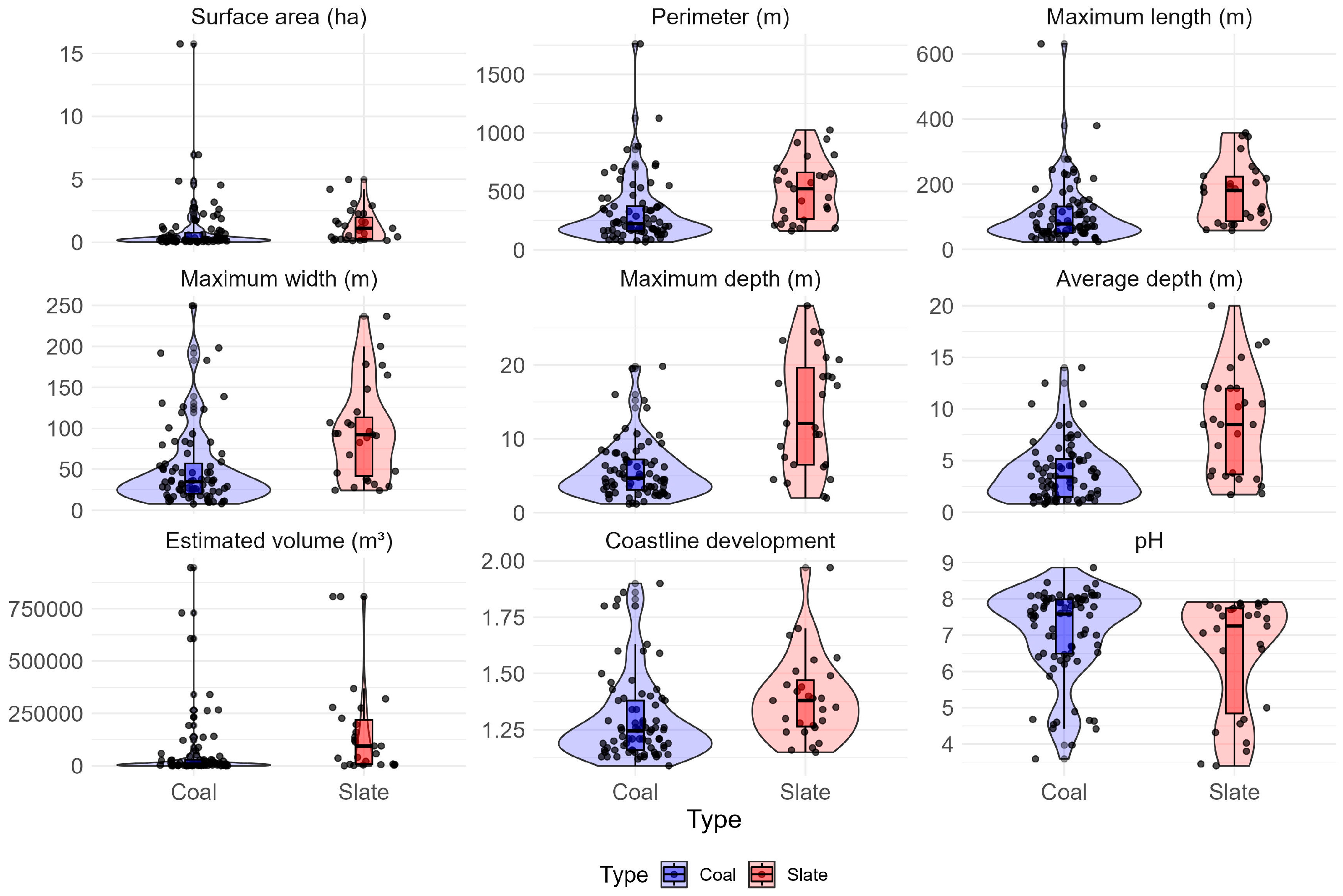
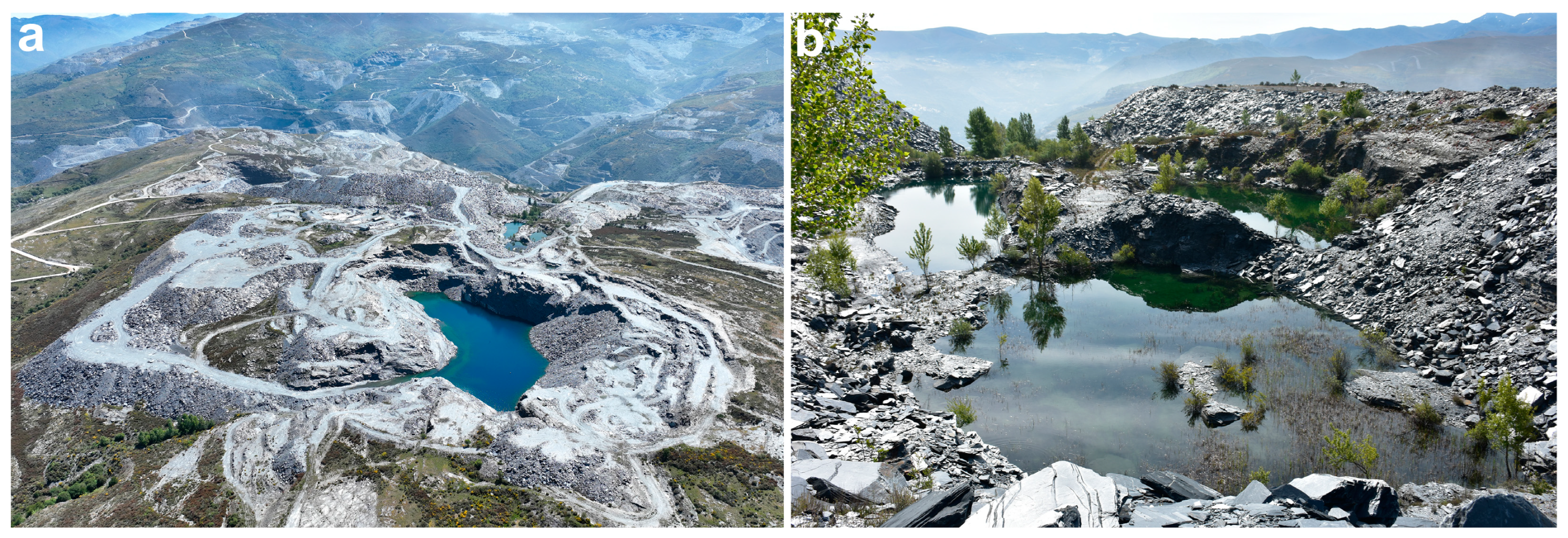
| Code | Prov | Locality | Location | Shape | Conn. | pH | S | P | L | W | Z | ZZ | V | DL | E |
|---|---|---|---|---|---|---|---|---|---|---|---|---|---|---|---|
| PI 01 | LE | Sorbeda | Slope | Subcir. | No | 3.4 | 1.69 | 595 | 193 | 107 | 23.3 | 16.5 | 278,860 | 1.3 | 1105 |
| PI 02 | LE | Susañe | Slope | Subcir. | No | 4.6 | 0.21 | 208 | 72 | 28 | 6.5 | 3.5 | 7493 | 1.3 | 904 |
| PI 03 | LE | Páramo | Slope | Subcir. | No | 6.6 | 1.12 | 523 | 202 | 89 | 11.5 | 8.5 | 94,844 | 1.4 | 859 |
| PI 04 | LE | Páramo | Slope | Subcir. | No | 7.5 | 0.14 | 184 | 83 | 24 | 7.5 | 4.0 | 5595 | 1.4 | 872 |
| PI 05 | LE | Páramo | Slope | Subcir. | Yes | 7.2 | 0.25 | 255 | 81 | 46 | 10.6 | 8.5 | 21,229 | 1.4 | 885 |
| PI 06 | LE | Forna | Slope | Subcir. | No | 7.8 | 0.43 | 338 | 98 | 83 | 10.6 | 8.5 | 36,634 | 1.5 | 1464 |
| PI 07 | LE | Forna | Valley b. | Subcir. | Yes | 7.9 | 1.65 | 635 | 205 | 120 | 18.4 | 12.0 | 197,434 | 1.4 | 1398 |
| PI 08 | LE | Benuza | Valley b. | E. Subrec. | Yes | 7.8 | 0.41 | 447 | 190 | 24 | 4.5 | 3.8 | 15,605 | 2.0 | 1220 |
| PI 09 | C | O Lambao | Valley b. | Subcir. | Yes | 4.3 | 2.29 | 813 | 358 | 96 | 21.0 | 14.0 | 320,328 | 1.5 | 317 |
| PI 10 | C | Mt Rande | Slope | Subcir. | No | 3.8 | 2.90 | 948 | 346 | 148 | 28.0 | 20.0 | 580,940 | 1.6 | 269 |
| PI 11 | ZA | Boya | Slope | Subcir. | No | 3.5 | 1.30 | 575 | 176 | 104 | 18.5 | 10.6 | 137,883 | 1.4 | 866 |
| PI 12 | ZA | S. Pedro | Valley b. | Circular | No | 4.7 | 2.26 | 624 | 187 | 177 | 24.4 | 12.2 | 275,954 | 1.2 | 858 |
| PI 13 | ZA | Flechas | Valley b. | E. Subrec. | No | 7.7 | 1.17 | 651 | 226 | 107 | 18.3 | 10.5 | 122,459 | 1.7 | 811 |
| PI 14 | ZA | Palazuelo | Valley b. | Subcir. | Yes | 6.8 | 0.53 | 352 | 112 | 68 | 12.1 | 7.6 | 40,659 | 1.4 | 791 |
| PI 15 | ZA | Palazuelo | Valley b. | Circular | No | 7.5 | 4.98 | 917 | 349 | 200 | 24.5 | 16.2 | 807,374 | 1.2 | 780 |
| PI 16 | ZA | Riofrío | Valley b. | Circular | Yes | 7.9 | 0.25 | 220 | 76 | 48 | 6.2 | 3.5 | 8755 | 1.2 | 975 |
| PI 17 | OR | Pusmazán | Valley b. | E. Subrec. | Yes | 7.3 | 0.21 | 271 | 110 | 38 | 4.0 | 3.2 | 6605 | 1.7 | 1204 |
| PI 18 | OR | Pusmazán | Valley b. | Subcir. | No | 7.8 | 0.16 | 211 | 76 | 32 | 4.5 | 2.5 | 3943 | 1.5 | 1207 |
| PI 19 | OR | Pusmazán | Valley b. | Subcir. | No | 7.6 | 0.16 | 186 | 58 | 36 | 2.0 | 1.7 | 2759 | 1.3 | 1207 |
| PI 20 | OR | Pusmazán | Valley b. | Subcir. | No | 7.5 | 0.13 | 161 | 61 | 29 | 2.2 | 1.8 | 226,940 | 1.3 | 1223 |
| PI 21 | OR | Pusmazán | Valley b. | E. Subrec. | Yes | 7.7 | 1.57 | 698 | 255 | 91 | 20.7 | 10.2 | 160,474 | 1.6 | 966 |
| PI 22 | OR | Riodolas | Valley b. | Circular | No | 7.9 | 2.52 | 673 | 241 | 165 | 16.0 | 9.0 | 227,070 | 1.2 | 635 |
| PI 23 | OR | Casaio | Valley b. | Subcir. | No | 4.0 | 3.08 | 802 | 278 | 178 | 17.2 | 12.0 | 369,130 | 1.3 | 683 |
| PI 24 | OR | Casaio | Valley b. | Subcir. | No | 6.6 | 4.21 | 1024 | 310 | 237 | 23.0 | 15.0 | 807,374 | 1.4 | 854 |
| PI 25 | OR | Casaio | Valley b. | Circular | No | 7.1 | 0.94 | 418 | 131 | 92 | 17.5 | 12.0 | 113,278 | 1.2 | 1039 |
| PI 26 | LU | Pacios | Valley b. | Circular | No | 5.0 | 0.69 | 368 | 124 | 94 | 6.5 | 3.2 | 222 | 1.2 | 733 |
| PI 27 | LU | Villarbacú | Valley b. | Subcir. | Yes | 7.8 | 1.48 | 562 | 218 | 94 | 9.0 | 6.5 | 95,209 | 1.3 | 808 |
Disclaimer/Publisher’s Note: The statements, opinions and data contained in all publications are solely those of the individual author(s) and contributor(s) and not of MDPI and/or the editor(s). MDPI and/or the editor(s) disclaim responsibility for any injury to people or property resulting from any ideas, methods, instructions or products referred to in the content. |
© 2024 by the authors. Licensee MDPI, Basel, Switzerland. This article is an open access article distributed under the terms and conditions of the Creative Commons Attribution (CC BY) license (https://creativecommons.org/licenses/by/4.0/).
Share and Cite
Redondo-Vega, J.M.; Santos-González, J.; Melón-Nava, A.; Gómez-Villar, A.; Peña-Pérez, S.A.; González-Gutiérrez, R.B. Pit Lakes in Abandoned Slate Quarries in Northwestern Spain: Characteristics and Potential Uses. Water 2024, 16, 2403. https://doi.org/10.3390/w16172403
Redondo-Vega JM, Santos-González J, Melón-Nava A, Gómez-Villar A, Peña-Pérez SA, González-Gutiérrez RB. Pit Lakes in Abandoned Slate Quarries in Northwestern Spain: Characteristics and Potential Uses. Water. 2024; 16(17):2403. https://doi.org/10.3390/w16172403
Chicago/Turabian StyleRedondo-Vega, José María, Javier Santos-González, Adrián Melón-Nava, Amelia Gómez-Villar, Sergio A. Peña-Pérez, and Rosa Blanca González-Gutiérrez. 2024. "Pit Lakes in Abandoned Slate Quarries in Northwestern Spain: Characteristics and Potential Uses" Water 16, no. 17: 2403. https://doi.org/10.3390/w16172403
APA StyleRedondo-Vega, J. M., Santos-González, J., Melón-Nava, A., Gómez-Villar, A., Peña-Pérez, S. A., & González-Gutiérrez, R. B. (2024). Pit Lakes in Abandoned Slate Quarries in Northwestern Spain: Characteristics and Potential Uses. Water, 16(17), 2403. https://doi.org/10.3390/w16172403







